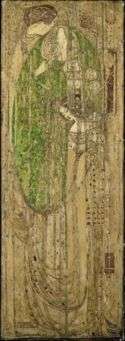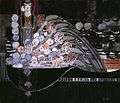Margaret Macdonald Mackintosh
| Margaret Macdonald Mackintosh | |
|---|---|
 | |
| Born |
Margaret Macdonald 5 November 1864 Tipton, England, United Kingdom |
| Died |
7 January 1933 (aged 67) Chelsea, England, United Kingdom |
| Nationality | Scottish |
| Education | Glasgow School of Art |
| Known for | Decorative Arts, Design |
| Movement | Art Nouveau, Glasgow Style, Symbolism |
| Spouse(s) | Charles Rennie Mackintosh |
Margaret Macdonald Mackintosh (5 November 1864 – 7 January 1933) was a Scottish artist whose design work became one of the defining features of the "Glasgow Style" during the 1890s.
Biography
Born Margaret Macdonald, at Tipton, near Wolverhampton, her father was a colliery manager and engineer. Margaret and her younger sister Frances both attended the Orme Girls' School, Newcastle-under-Lyme, Staffordshire. Their names occur in the school register.[1] In the 1881 census Margaret, aged 16, was said to be a scholar. She was a visitor at someone else's house on census night.[2] By 1890 the family had settled in Glasgow and Margaret and her sister, Frances Macdonald, enrolled as students at the Glasgow School of Art.[3] There she worked in a variety of media, including metalwork, embroidery, and textiles.
She was first a collaborator with her sister, Frances, and in the 1890s the pair opened the MacDonald Sisters Studio at 128 Hope Street, Glasgow. Their innovative work was inspired by Celtic imagery, literature, symbolism, and folklore.[4] She later collaborated with her husband, the architect and designer Charles Rennie Mackintosh. They married on 22 August 1900.[5] Her most dynamic works are large gesso panels made for the interiors that she designed with Mackintosh, such as tearooms and private residences.
Charles Rennie Mackintosh is commonly recognized as Scotland's most famous architect, while Margaret is traditionally depicted as his supportive spouse.[4] Yet Mackintosh has admitted that much of his success and creativity is in fact to be attributed to the influence of his wife, who he referred to as a "genius."[6]
Together with her husband, her sister, and Herbert MacNair, she was one of the most influential members of the loose collective of the Glasgow School known as "The Four". She exhibited with Mackintosh at the 1900 Vienna Secession, where she was arguably an influence on the Secessionists Gustav Klimt and Josef Hoffmann.
The Glasgow Four
Macdonald was celebrated in her time by many of her peers, including her husband who once wrote in a letter to Margaret "Remember, you are half if not three-quarters in all my architectural work ...";[7] and reportedly "Margaret has genius, I have only talent."[6] It is not known exactly which of Charles Rennie Mackintosh's works Margaret was involved with (or the extent to which she worked on them) but she is credited with being an important part of her husband's figurative, symbolic interior designs. Many of these were executed at the early part of the twentieth century; and include the Rose Boudoir at the International Exhibition at Turin in 1903, the designs for House for an Art Lover in 1900, and the Willow Tea Rooms in 1902. Active and recognized during her career, between 1895 and 1924 she contributed to more than 40 European and American exhibitions.[4] Poor health cut short Margaret's career and, as far as is known, she produced no work after 1921.[8] She died in 1933, five years after her husband.
Inspiration and style
Macdonald did not keep sketchbooks, which reflects her reliance on imagination rather than on nature.[9] A few sources provided significant inspiration for her works, including the Bible, the Odyssey, poems by Morris and Rossetti, and the works of Maurice Maeterlinck.[9] Her works, along with those works of her often collaborating sister, defied her contemporaries' conceptions of art. Gleeson White wrote, "With a delightfully innocent air these two sisters disclaim any attempt to acknowledge that Egyptian decoration has interested them specially. 'We have no basis.' Nor do they advance any theory."[10]
The beginning of Macdonald's artistic career reflects broad strokes of experimentation. Largely drawing from her imagination, she reinterpreted traditional themes, allegories, and symbols in inventive ways.[11] For instance, immediately following the 1896 opening of her Glasgow studio with her sister, she transformed broad ideas such as "Time" and "Summer" into highly stylized human forms.[12] Many of her works incorporate muted natural tones, elongated nude human forms, and a subtle interplay between geometric and natural motifs. Above all, her designs demonstrated a type of originality that distinguishes her from other artists of her time.[13]
Popular work
Her best-known works include the gesso panel The May Queen, which was made to partner Mackintosh's panel The Wassail for Miss Cranston's Ingram Street Tearooms, and Oh ye, all ye that walk in Willowood, which formed part of the decorative scheme for the Room de Luxe in the Willow Tearooms. All three of these are now on display in the Kelvingrove Museum in Glasgow. In 2008 her 1902 work The Red Rose and the White Rose was auctioned for 1.7 million UK pounds or $3.3 million.[14]
Gallery
-

Winter, 1898.
-

The May Queen, 1900.[1]
-

Embroidered panels, 1902.
-

White Rose And Red Rose, 1902.
-

Oh ye, all ye that walk in Willowood, 1903.
-

Opera Of The Winds, 1903.
-

Ophelia, 1908.
-
_by_Margaret_Macdonald_Mackintosh.jpg)
The Mysterious Garden, 1911.
-

The Opera of the Seas, 1915.
-

La mort parfumée, 1921.
-

Menu card design, 1911.
-

The Room de Luxe at the Willow Tea Rooms.
References
- ↑ Orme Girls' School, Newcastle-under-Lyme, Registers
- ↑ 1881 Census
- ↑ "The Mysterious Garden – Margaret Macdonald Mackintosh". National Galleries of Scotland. Retrieved 25 October 2015.
- 1 2 3 Panther, Patricia. "Margaret MacDonald: the talented other half of Charles Rennie Mackintosh". BBC. BBC. Retrieved 8 March 2015.
- ↑ "MX.04 Interiors for 120 Mains Street" (PDF). Mackintosh Architecture : Context, Making and Meaning. University of Glasgos. Retrieved 4 December 2014.
- 1 2 Kirkham, Pat (2001). Charles and Ray Eames: Designers of the Twentieth Century (Fourth ed.). United States of America: Massachusetts Institute of Technology. p. 81.
- ↑ The Chronicle: the letters of Charles Rennie Mackintosh to Margaret Macdonald Mackintosh, Pamela Robertson, ed.
- ↑ "Margaret Macdonald (1864–1933)". Charles Rennie Mackintosh Society. Retrieved 25 October 2015.
- 1 2 Robertson, Pamela (1990). "Margaret Macdonald Mackintosh (1864–1933)". In Burkhauser, Jude. 'Glasgow Girls': Women in Art and Design 1880–1920. Edinburgh: Canongate. p. 113. ISBN 978-1-84195-151-5.
- ↑ Robertson, Pamela (1990). "Margaret Macdonald Mackintosh (1864–1933)". In Burkhauser, Jude. 'Glasgow Girls': Women in Art and Design 1880–1920. Edinburgh: Canongate. p. 112. ISBN 978-1-84195-151-5.
- ↑ Neat, Timothy (1990). "Tinker, Tailor, Soldier, Sailor: Margaret Macdonald and the Principle of Choice". In Burkhauser, Jude. 'Glasgow Girls': Women in Art and Design 1880–1920. Edinburgh: Canongate. p. 117. ISBN 978-1-84195-151-5.
- ↑ Robertson, Pamela (1990). "Margaret Macdonald Mackintosh (1864–1933)". In Burkhauser, Jude. 'Glasgow Girls': Women in Art and Design 1880–1920. Edinburgh: Canongate. p. 110. ISBN 978-1-84195-151-5.
- ↑ Robertson, Pamela (1990). "Margaret Macdonald Mackintosh (1864–1933)". In Burkhauser, Jude. 'Glasgow Girls': Women in Art and Design 1880–1920. Edinburgh: Canongate. p. 109. ISBN 978-1-84195-151-5.
- ↑ "MARGARET MACDONALD MACKINTOSH THE WHITE ROSE AND THE RED ROSE, 1902". Christie's. Retrieved 25 October 2015.
External links
| Wikimedia Commons has media related to Margaret MacDonald. |
- Biography at the Charles Rennie Mackintosh Society
- works by Margaret Macdonald in the Hunterian Art Gallery Collections
- Information on The Group of Four from the Hunterian Art Gallery
|